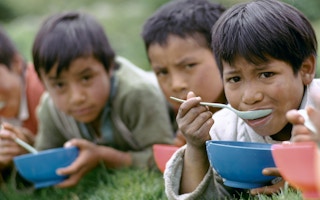Rising carbon emissions could make vital food crops from wheat to rice less nutritious and endanger the health of hundreds of millions of the world’s poorest, scientists said on Monday.
Certain staple crops grown in open fields with elevated carbon dioxide levels had up to 17 percent lower levels of protein, iron and zinc compared to those grown amid less of the gas, according to a study in the journal Nature Climate Change.
Global emissions of carbon dioxide, largely from fossil-fuel use, are at record highs and the primary cause of global average temperature rise, which countries are seeking to curb to avoid the most devastating effects.
Nearly 200 countries reached an agreement two years ago in Paris to curb emissions.
The research found that by 2050, nearly 300 million people could lack enough zinc or protein and 1.4 billion women and children will be vulnerable to iron deficiency - all linked to carbon emissions - fuelling the risk of disease and early death.
While carbon emissions and global warming disrupt food production through extreme weather such as drought and floods, these findings warn of a direct yet mostly invisible impact on people’s diets, said Matthew Smith, an author of the study. “It’s more hidden … most people wouldn’t necessarily notice if they lost 5 percent of iron or zinc from their wheat, but it could have broad ranging health effects,” said the research associate at the Harvard T. H. Chan School of Public Health.
“
Climate change is not good for health. It’s more evidence that something really needs to be done to reduce carbon emissions.
Marion Nestle, professor of nutrition, food studies and public health, New York University
The main theory behind the link is that carbon dioxide makes plants grow faster and create fewer micro-nutrients, he added.
By mid-century, areas at highest risk of growing less nutitious food are some of the world’s poorest - India, Africa, the Middle East and Southeast Asia - which rely on grains most vulnerable to the effects of carbon, such as wheat and rice.
People with zinc deficiencies, especially children, can have impaired immune systems and are more susceptible to get and die from malaria and respiratory infections, Smith said.
Iron deficiency raises rates of maternal and newborn deaths and lowers cognitive abilities, while a lack of protein is linked to stunting, wasting and low birth weight, he said.
“Climate change is not good for health,” Marion Nestle, professor of nutrition, food studies and public health at New York University, told the Thomson Reuters Foundation.
“It’s more evidence that something really needs to be done to reduce carbon emissions.”
Global energy-related carbon emissions rose to a record high of 32.5 gigatons last year, after three years of being flat, due to higher energy demand and the slowing of energy efficiency improvements, according to the International Energy Agency.
This story was published with permission from Thomson Reuters Foundation, the charitable arm of Thomson Reuters, that covers humanitarian news, women’s rights, trafficking, property rights, climate change and resilience. Visit http://news.trust.org)










